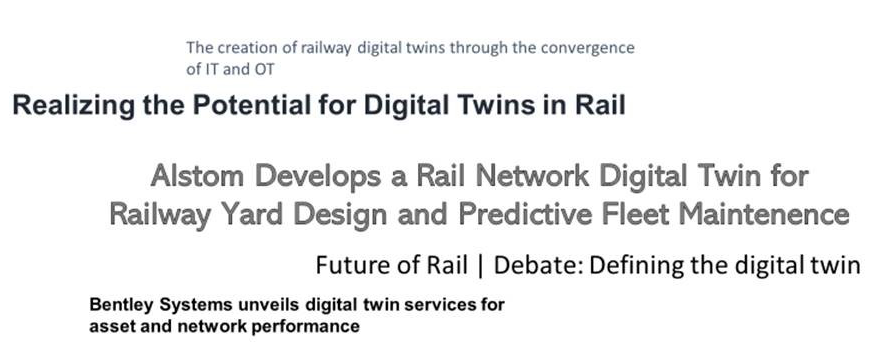Digital Twins for Rail - Going Beyond the Buzzword
Authors: Luisa Moisio - R&D Programme Director, RSSB and Clive Roberts - Director, BCRRE, University of Birmingham.
This process of ‘duplication’ enables long and short-term decisions and actions affecting systems to be tested in advance. In this way the implications of these decisions and actions can be assessed before they are implemented in the real world. The digital twin can also be used to provide warnings on the status of the system, enabling early interventions, as well as support planning and investment decisions.
Because of its potential for improving productivity, efficiency, availability, and reliability of systems (and sub-systems), digital twin has emerged over recent years as something of a technology buzzword.

2010-present worldwide google searches for ‘digital twins’
This enthusiasm has been picked up in rail where several ‘railway digital twins’ appear to be in development or even deployed. There is both genuine interest among the wider rail community and understandable scepticism, prompting a range of relevant and useful questions. Some are technical: where does a model or simulation stop and become a digital twin? And some are more fundamental: can we actually create an all-encompassing ‘fully twinned’ digital version of the railway?

Digital Twins are already being used in different industries, particularly in manufacturing. It’s anticipated their development and deployment will grow significantly over the coming decade. However, there is, as yet, no example of a system as complicated and complex as a railway being fully modelled by Digital Twin technology.
Given the nature of the railway, Digital Twins could be used across a variety of different engineering, operational and planning applications. These include, but are not limited to, physical assets (both rolling stock and infrastructure), train movements, and interactions with customer behaviour in stations, platforms and trains. Whether and how we can move from digital twins related to specific assets and processes to something that brings together these different pieces in a ‘railway digital twin’ is a key question.
Only initial and limited discussions have happened on what a suitable Digital Twin for the rail industry could look like. These have not yet generated an agreed understanding on what this would need to be, what it should support, and how it should be developed and by whom.
For the railway to make a considered decision when it comes to Digital Twins, it is essential to take a closer look at current rail-related initiatives and products in this space. What is their state of actual development? What are their applications and range of potential benefits? The second big area that needs exploring is how to bring together the different applications and stakeholders into an actual railway digital twin.
RSSB and BCRRE – the UKRRIN Centre for Excellence in Digital Systems – have joined forces to explore current thinking and experiences with this emergent technology within the sector and beyond. We believe this can be a first important step in building a common working language that can be used throughout the industry for the application of this technology. Our ambition is for this series to help lay the foundations for a ‘roadmap’ for the future development and deployment of digital twins in rail.
This series will cover a variety of aspects, including ‘twinned trains’, ‘twinfrastructure’ and the challenge to connect them together. It will look at what a digital twinned railway can do for passengers and the workforce, before opening the discussion on how we can make this happen across the sector.
We hope you enjoy this series and get involved in the discussions. Please share your ideas and thoughts through LinkedIn and Twitter, where this publication will be relayed.

